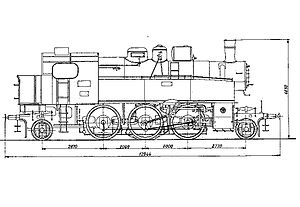MÁV series 315
| MÁV series 315 | |
|---|---|
|
Dimensional sketch
|
|
| Numbering: | MÁV 315.801-818 |
| Number: | 18th |
| Manufacturer: | MÁVAG , Budapest |
| Year of construction (s): | 1917-1918 |
| Retirement: | until 1972 |
| Axis formula : | 1'C1 'h2 |
| Gauge : | 1435 mm ( standard gauge ) |
| Length over buffers: | 12,944 mm |
| Height: | 4,650 mm |
| Width: | 3,120 mm |
| Fixed wheelbase: | 4,000 mm |
| Total wheelbase: | 9,640 mm |
| Smallest bef. Radius: | 120 m |
| Empty mass: | 57 t |
| Service mass: | 74 t |
| Friction mass: | 45.56 t |
| Wheel set mass : | 15.2 t |
| Top speed: | 90 km / h |
| Indexed performance : | 950 hp |
| Driving wheel diameter: | 1,606 mm |
| Impeller diameter: | 950 mm |
| Control type : | Heusinger control |
| Number of cylinders: | 2 |
| Cylinder diameter: | 500 mm |
| Piston stroke: | 650 mm |
| Boiler : | Brotan kettle |
| Cup length: | 3,850 mm |
| Boiler overpressure: | 13 bar |
| Number of heating pipes: | 95 |
| Grate area: | 2.34 m² |
| Superheater area : | 51 m² |
| Evaporation heating surface: | 119 m² (in contact with water) |
| Water supply: | 9 m³ |
| Fuel supply: | 6 t |
| Brake: | Westinghouse brake |
| Speedometer: | Steward |
| Control: | Heusinger |
The MÁV class 315 was a passenger train - tank locomotive series of the Hungarian State Railways MÁV for suburban traffic in the Budapest area on routes with fast changes of direction without the possibility of turning. None of the locomotives have survived.
history
This locomotive is a variant of the MÁV class 342 . It was used in suburban traffic from Budapest. Due to the better superstructure available there, series with higher axle loads could run. Therefore, MÁVAG installed larger storage tanks for water and coal in order to increase the operating range. Otherwise the vehicles were identical to the MÁV series 342 . The coupling axle pressure also increased, which resulted in a higher frictional weight and thus a higher tensile force. The locomotives could only be used in the Budapest area.
In 1943 the area of operation of the locomotives had shifted somewhat; seven locomotives were still used in Budapest, four locomotives performed their service in Nové Zámky in Slovakia , four locomotives were used in the boiler house of Ilva Mică in Romania and the remaining three in Subotica in Serbia .
After the end of the Second World War , there were still twelve locomotives in Hungary . One of them was operational, three under repair and eight parked. Of these eight locomotives, three were so badly damaged that it was no longer worth rebuilding. The remainder could be returned to the driving service after extensive repairs. In 1951 six locomotives were in operation and were used in the Budapest area. Apparently there were still 14 locomotives in total. From 1966 the retirement began; That year, one locomotive was retired, five followed in 1967, one in 1968, three in 1969, two in 1970 and the remaining two in 1972.
See also
literature
- Mihály Kubinszky (ed.): Hungarian locomotives and railcars , Akadémiai Kiadó, Budapest 1975, ISBN 963-05-0125-2 .
